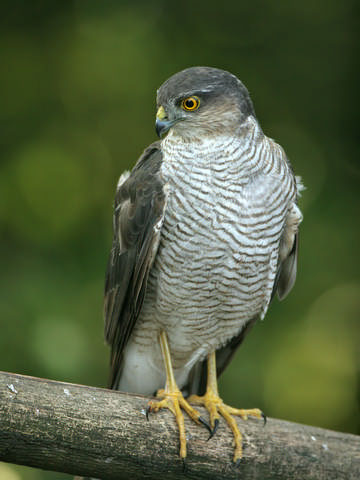
Sparrowhawk © Steve Round
Most Sparrowhawks which have good-quality territories remain in them all year round, while those on low grade territories tend to move away, whether they had successfully bred or not. First-year birds spend much of the winter trying to find a suitable territory, although not many succeed, fewer than 20% of birds breeding at one year of age. There is also an influx in winter of migratory birds, mostly from Norway and Denmark (Migration Atlas). There is thus no reason why the winter distribution map of Sparrowhawk should be similar to that for the breeding season, but it is: the species is widespread but missing from the sparsely-wooded areas of central Cheshire and not found in some of the bleakest upland tetrads.
In winter, there is less reason for the apparent correlation with woodland because the sexes tend to separate, males hunting mostly in woodland and females more often in open country. This is dictated partly by their size and manoeuvrability, allied to the likely habitat preferences of their favoured prey. In summer, their prey is overwhelmingly the naïve fledglings but by wintertime, the easy pickings have gone and birds are more difficult to catch. The range over which Sparrowhawks have to hunt to fulfil their daily needs increases greatly, to a mean of 350 ha at low elevations – ten times the breeding season figure – and more than 800 ha (two tetrads) at 200 m altitude (Newton 1986); these figures are for male birds, with females travelling perhaps twice as far, covering four times the area. The greater variety of habitats covered in winter is shown by the recorded habitat codes, with 27% woodland, 5% scrub, 2% semi-natural grassland and marsh, 44% farmland and 21% human sites.
When they have no chicks to feed, Sparrowhawks hunt mainly in the first three hours of daylight, then are inactive for large parts of the day, usually from late morning onwards. There is a late-afternoon flurry, especially by first-year hawks, as some of them attack birds coming into roosts. I have found, in 23 years of ringing birds roosting at Norton Priory, Runcorn, a significant correlation from year to year between the total of thrushes ringed and the number of Sparrowhawks caught: in years with more thrushes roosting, there are likely to be more hawks visiting.
Coward and Oldham noted that ‘in winter the Sparrowhawk frequents the more open country. It hunts over a regular beat as a rule, passing a given spot about the same time day after day’. To Boyd (1951) the species was a fairly common resident, but by Bell’s time (1962 and 1967) it had become very scarce, as the lethal impact of organochlorine pesticides hit them hard. The present county population may well be the highest in recorded ornithology.
Sponsored by James Quinn

